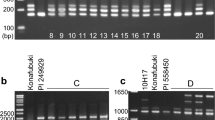Abstract
Diploid wild potato species, classified as 1EBN (Endosperm Balance Number), do not cross with tetraploid or diploid forms ofS. tuberosum Gp. Tuberosum. The crossing of 2n pollen producing 1EBN clones as well as chromosome-doubled 1EBN clones with Gp. Tuberosum haploids was initiated to overcome this hybridization barrier. The screening of eleven 1EBN species,S. brachistotrichum, S. bulbocastanum, S. cardiophyllum, S. chancayense, S. commersonii, S. etuberosum, S. fernandezianum, S. jamesii, S. mochicense, S. pinnatisectum andS. trifidum, resulted in the identification of 2n pollen producers in eight of the species examined. Direct hybridization with Gp. Tuberosum haploids utilizing the above-mentioned crossing scheme was successful withS. chancayense andS. commersonii. The hybrids obtained, however, were male and female sterile. Abnormal microsporogenesis in the hybrids was postulated to be the result of an interaction between Gp. Tuberosum cytoplasm and nuclear genes contributed by the 1EBN male parent. Analyses of the growth of 1EBN species’ pollen tubes in the stigma/style of Gp. Tuberosum haploids were also conducted. Interspecific incompatibilities were observed with the most severe forms found with the use of species in the Series Etuberosa. The use of the Endosperm Balance Number theory can aid in designing crosses which overcome barriers to successful endosperm development. Sterilities in the hybrids obtained as well as interspecific incompatibilities will also need to be addressed, however, before 1EBN species germplasm can be successfully utilized for the improvement of the cultivated potato.
Compendio
Especies silvestres diploides de papa, clasificadas como 1EBN (Número de Balance del Endosperma), no se cruzan con las formas tetraploides o diploides deS. tuberosum Gp. Tuberosum. Se inició el cruzamiento de clones 1EBN productores de polen 2n, al iguao que el de clones 1EBN con cromosomas doblados, con haploides del Gp. Tuberosum, para eliminar esta bar rera a la hibridación. La evaluatión y selectión de once especies 1EBN,S. brachistotrichum, S. bulbocastanum, S. cardiophyllum, S. chancayense, S. commersonni, S. etuberosum, S. fernandezianum, S. jamesii, S. mochicense, S. pinnatisectum yS. trifidum, dió por resultado la identificatión de productores de polen 2n en ocho de las especies examinadas. La hibridación directa con haploides del Gp. Tuberosum utilizando los sistemas de cruzamientos mencionados anteriormente fue exitosa conS. chancayense yS. commersonii. Sin embargo, los híbridos obtenidos fueron totalmente estériles. Se supone que la microesporogenesis anormal en los híbridos es el resultado de una interaction entre el citoplasma del Gp. Tuberosum y los genes nucleares pertenecientes al progenitor masculino 1EBN. Se condujeron también análisis del crecimiento de los tubos polínicos de las especies 1EBN en el estigma/estilo de los haploides del Gp. Tuberosum. Se observaron incompatibilidades interespecíficas con las formas más severas encontradas con el uso de especies en la Serie Etuberosa. El uso de la teoría del Número de Balance del Endosperma puede servir para diseñar cruzamientos que superen las barreras para el desarrollo exitoso del endosperma. Sin embargo, la esterilidad de los híbridos obtenidos, al igual que las incompatibilidades interespecíficas, necesitarán también ser corregidas antes que el germoplasma de especies 1EBN pueda ser exitosamente utilizado para el mejoramiento de la papa cultivada.
Similar content being viewed by others
Literature Cited
Chavez, R., C.R. Brown and M. Iwanaga. 1988. Transfer of resistance to PLRV titer buildup fromSolanum etuberosum to a tuber-bearingSolanum gene pool. Theor Appl Genet 76:129–135.
Dionne, L.A. 1961. Mechanisms of interspecific incompatibility in tuber-bearingSolanum species. Am Potato J 38:73–77.
Dionne, L.A. 1963. Studies on the useof Solanum acaule as a bridge betweenSolanum tuberosum and species in the seriesBulbocastana, Cardiophylla andPinnatisecta. Euphytica 12:263–269.
Graham, K.M., J.S. Niederhauser and Leopoldo Servin. 1959. Studies on fertility and late blight resistance inSolanum bulbocastanum Dun. in Mexico. Can J Bot 37:41–49.
Grun, P. and M. Aubertin. 1966. Cytological expressions of a cytoplasmic male sterility inSolanum. Am J Bot 53:295–301.
Hermsen, J.G. Th. 1984. Pathway for transfer of PLRV resistance from non-tuberousSolanum species to potato cultivars. EAPR-Proc Ninth Trien Conf. p. 286–287.
Hermsen, J.G. Th. and M.S. Ramanna. 1973. Double-bridge hybrids ofSolanum bulbocastanum and cultivars ofSolanum tuberosum. Euphytica 22:557–566.
Hermundstad, S.A. & S.J. Peloquin. 1985. Germplasm enhancement with potato haploids. J Hered 76:463–467.
Huaman, Z. and R. W. Ross. 1985. Updated listing of potato species names, abbreviations and taxonomic status. Am Potato J 62:629–641.
Johnston, S.A., T.P.M. den Nijs, S.J. Peloquin and R.E. Hanneman, Jr. 1980. The significance of genic balance to endosperm development in interspecific crosses. Theor Appl Genet 57:5–9.
Lewis, D. and L.K. Crowe. 1958. Unilateral interspecific incompatibility in flowering plants. Heredity 12:233–256.
Livermore, J.R. and F.E. Johnstone, Jr. 1940. The effect of chromosome doubling on the crossabilityof Solanum chacoense, S. jamesii, andS. bulbocastanum withS. tuberosum. Am Potato J 17:170–173.
McLean, J.G. and F.J. Stevenson. 1952. Methods of obtaining seed on Russet Burbank and similar flowering varieties of potatoes. Am Potato J 29:206–211.
Quinn, A.A., D.W.S. Mok and S.J. Peloquin. 1974. Distribution and significance of diplandroids among the diploid Solanums. Am Potato J 51:16–21.
Swaminathan, M.S. 1955. Overcoming cross-incompatibility among some Mexican diploid species ofSolanum. Nature 176:887–888.
Watanabe, K. and S.J. Peloquin. 1989. Occurrence of 2n pollen and ps gene frequencies in cultivated groups and their related wild species in tuber-bearing Solanums. Theor Appl Genet 78:329–336.
Yerk, G.L. & S.J. Peloquin. 1988. 2n pollen in eleven 2x, 2EBN wild species and their haploid × wild species hybrids. Potato Res 31:581–589.
Author information
Authors and Affiliations
Rights and permissions
About this article
Cite this article
Novy, R.G., Hanneman, R.E. Hybridization between Gp. Tuberosum Haploids and 1EBN wild potato species. American Potato Journal 68, 151–169 (1991). https://doi.org/10.1007/BF02853896
Accepted:
Issue Date:
DOI: https://doi.org/10.1007/BF02853896




